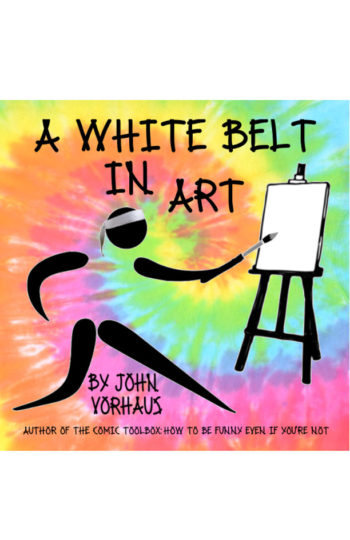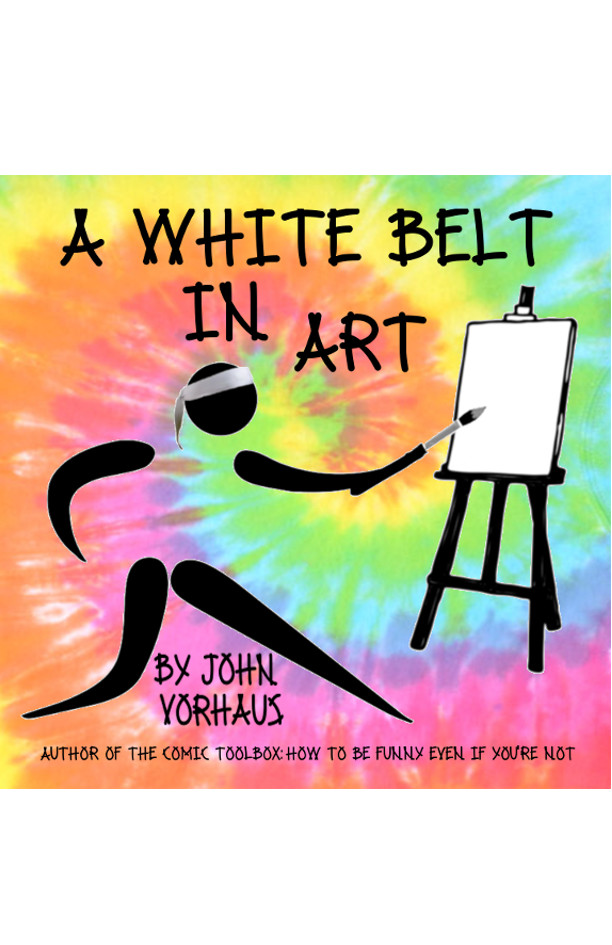Description
IN THE SPRING OF 2016 I HAD COME TO THE END OF A CERTAIN ROAD
My writing was broken. I had run out of words and run out of passion for making them dance on the page. This had happened to me before, but never on so grand a life-squashing and ambition-shattering scale. I needed a radical solution and so, for the first time in my life, I did a deep dive into visual creativity. Never having made any sort of art before I was, of course, scared to death. So I set my sights quite low. I decided to seek a white belt in art — the one they give you for just showing up. When I started making interesting discoveries about how art works, and how I work within art, I thought there might be a book in all this. So I wrote it. And then my writing wasn’t broken anymore. Plus I learned how to make pictures.
A White Belt in Art. It’s a journey. It has a lot to say to artists and writers — creators of all stripes — especially to ones just starting out. It opens the door to creative process. It might very well open the door to yours. So buy it for yourself or give it to that earnest young striver in your life.
A White Belt in Art. I fixed myself through hard work by finding hard work I could stand to do. It worked for me and I betcha it works for you, too.
CHAPTER ONE: A SURGERY LOOMS
I like to apologize for my work before I do it.
In the spring of 2016, I had come to the end of a certain road.
After forty years of a productive and reasonably successful writing life, I had to admit that my enduring passion for writing books was not being matched in any meaningful way by the market’s passion for buying them. Having just released my latest work to no particular acclaim, I faced the daunting prospect of spending a year or more writing another book that too few people would read.
I couldn’t get psyched for that.
Worse, I’d lost my writing mojo. I didn’t feel like I had much of anything new to say on the page, nor was I particularly thrilled with most of what made its way there. I was unmoved. And unmoving.
At first this didn’t concern me, for in my long career as a writer I had lost and found my mojo many times. Being sick of your own work for a while but then falling in love with it again is a writer’s stock in trade. But this was different. This was burnout.
I just didn’t want to write anymore.
By coincidence or providence, I was about to undergo rotator cuff surgery, following which, under doctors’ orders, I anticipated not putting hand to computer keyboard for a month or two, maybe more.
I viewed this layoff as a blessing. I looked forward to letting my creative batteries discharge completely; to wandering in the green fields of new ideas; and to emerging in the fullness of time with my passion for writing reborn.
This begged the question of how I would find an audience for my next book, whatever it turned out to be. But I’d never really worried about that before and I tried not to worry about it now.
As for the feeling that I just didn’t want to write anymore, I ignored that, too. Writing was my job. If I found myself not loving my job, well, that’s a problem that lots of people have. I’d just have to suck it up and deal.
For the record, what cost me my rotator cuff and put me in this impending surgical pickle was my longtime devotion to the sport of ultimate frisbee, or just ultimate as it’s known, a team sport and a field sport, something like football or fútbol but without all the hitting, kicking and falling down.
As a kid I never felt at home in any sport, especially the hitting, kicking and falling down ones. I did love baseball, but I couldn’t run, hit, field, throw or catch and I was afraid of the ball, oh well.
But then I found ultimate, and in it I found an athletic practice, aerobic workout and groovy community that became fixtures in my life from the moment they entered my life. Three cheers for ultimate – playing it has kept me fit for more than four decades.
Except not my shoulder, which I killed to death with too many throws.
Surgery would fix that. They’d go in there with a belt sander, some anchor bolts and duct tape, and in half a year I’d be good as new.
But here’s what I hadn’t counted on: For those first months after surgery, when I was not writing, I would also not be running. There would be no happy exercise for this beslung and heavily harnessed fellow.
Now as a fully accredited armchair endocrinologist, I can tell you that exercise and creativity are two great sources of endorphins, those natural neurochemicals that tell the brain (well, at least this brain) that all is right with the world. I quickly figured out that I could live without writing and I could live without running, but living without both would be rough.
I met my exercise needs by just marching endlessly around my neighborhood like a one-armed madman. But I couldn’t write. Couldn’t even reach the keyboard.
How was I to fill my days?
As I learned in the first two weeks after surgery, you can only binge-watch so many episodes of Breaking Bad before your mind starts to melt. Suddenly what had looked like a welcome creative oasis was more like a creative desert, a place where I could easily die of creative thirst.
No sweat, right? Just talk into tape, right? Problem solved. But in my state of mind at the time, that wouldn’t work. I thought that dictating crappy stories would not be much different from typing them.
So there I was, in a bind.
I needed a creative practice; my wellness required it. And it had to be something that I could do one-handed – wrong-handed – with a computer mouse.
Up to that point, my only even remotely artistic experience had been simple book cover design using a computer application called GIMP – GNU Image Manipulation Program – the poor man’s (or broke man’s) Photoshop. It offers a pleasing array of shapers, stretchers, filters, cutters, pencils, brushes and other tools that one might use to make amazing, wonderful, beautiful art.
One might. Not me.
I couldn’t handle any of those tools.
Didn’t know how.
For though I had used the program, and ones like it, I’d never really learned them, not beyond the few spartan moves I used to create passable book covers within the limits of my gossamer skillset.
This wasn’t laziness on my part. It was stubborn self-definition. According to me, I was a writer, not an artist, so why waste time learning tools that weren’t in my line of work? This was tail-chasing logic and almost completely wrong, but that’s where my head was at; what are you gonna do?
One thing I had going for me: I could already drive a mouse left-handed. In the early days after surgery I found that there was a lot I could do at the computer, just not any typing.
So it suddenly occurred to me that I could devote this enforced hiatus of mine to really learning what GIMP could do and to learning what I could do with it. This would give me a creative outlet of sorts, and perhaps relieve the crankiness that was driving me nuts.
Only one problem. In order to do this experiment or exercise or whatever I wanted to call it, I would have to stop seeing myself as a writer and start seeing myself as an artist.
Okay, maybe not an artist artist, but at least not a non-artist.
It was a big hurdle. After all these years – decades, my whole life – of self-defining as a writer, I was suddenly going to self-define as something else? Who the hell does that? How does one do that? How does one dare? The change seemed so big, the ambition so grandiose, that it quickly overwhelmed me.
But as a writer of long experience, I’ve learned a thing or two about creative practice, and one thing I’ve learned is that when the task seems overwhelming, it’s usually because I’ve set the stakes too high. To lower the stakes, I merely needed to lower expectations – in this case really lower them, like all the way down to the floor.
When I asked myself how I might do that, the answer came to me in words, these words right here: I’ll get a white belt in art.
That’s where one starts in martial arts, right? In karate or judo, the first belt you get is the white belt – and you get it for just showing up. In going after a white belt I gave myself the freedom to experiment or explore, with no need to achieve. I didn’t have to make images that were amazing, wonderful or beautiful. I just had to show up.
Even at that, it was hard to get started. And it infuriated me that it was so hard. I’ve always seen myself as a risk taker. Where some may say, “I have not, therefore I must not,” I like to say, “I have not, therefore I will.” That’s what got me into writing in the first place – the audacious belief that I could make a go of it just by going for it.
I tried to use this approach in my early flirtations with GIMP, but I still got swamped by expectation, even after I had set the appropriate and reasonable goal of going for a humble white belt.
This was my dilemma: As a creative practitioner of long experience, I expected my outcomes to be good; however, as an artist of no experience, I couldn’t expect my outcomes to be good.
Worse, I had no way of knowing what a good outcome would look like. I knew what a good sentence looked like. It was structured a certain way, followed (or, knowingly, broke) certain rules of grammar and usage, and made its point in a linguistically pleasing way.
I couldn’t apply those same standards here.
I needed new standards.
Being the writer that I am, I decided to make some up.
~
Homework time, team: Between now and tomorrow, do something you’ve never done before. Doesn’t matter what – just do it. See how it feels. It’ll probably feel great. But in any case, do it. Do anything new. Because if this book is all about “the new,” that’s not just my new but your new, too.
